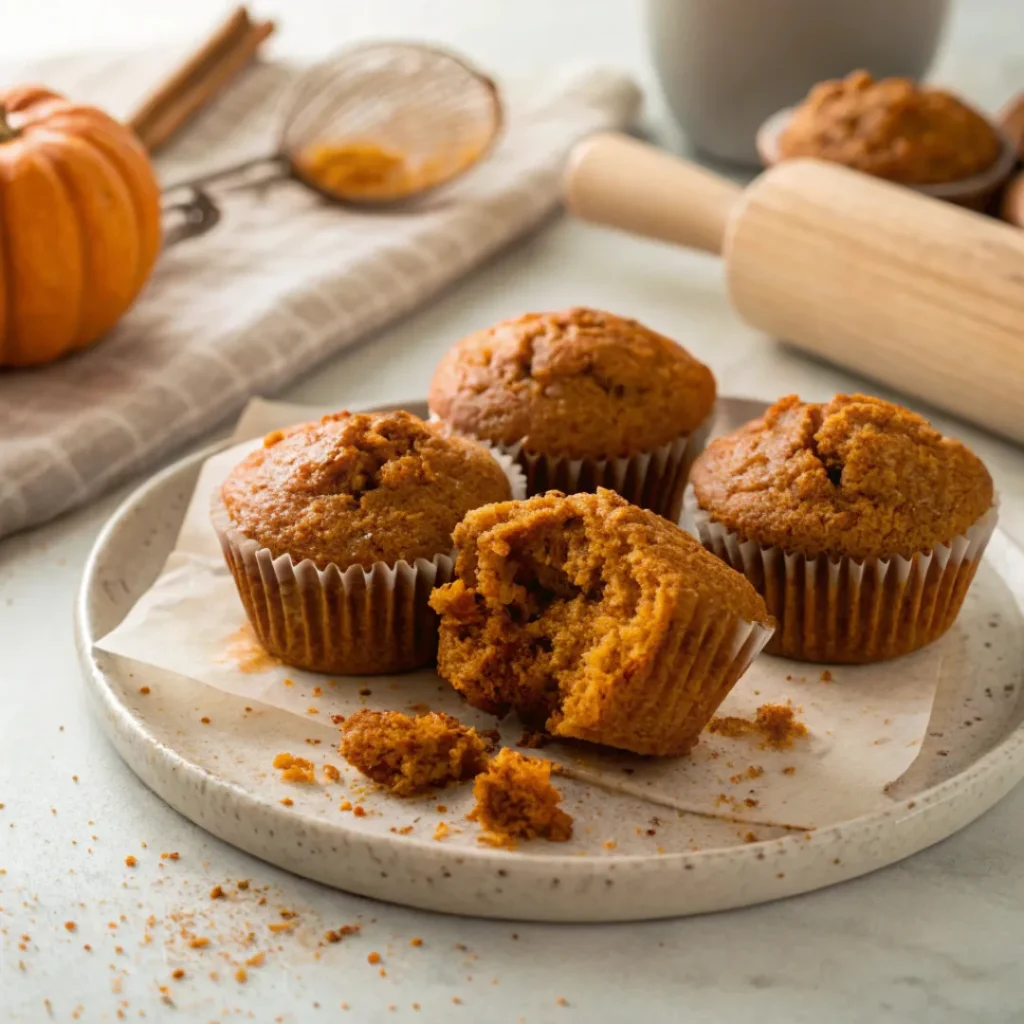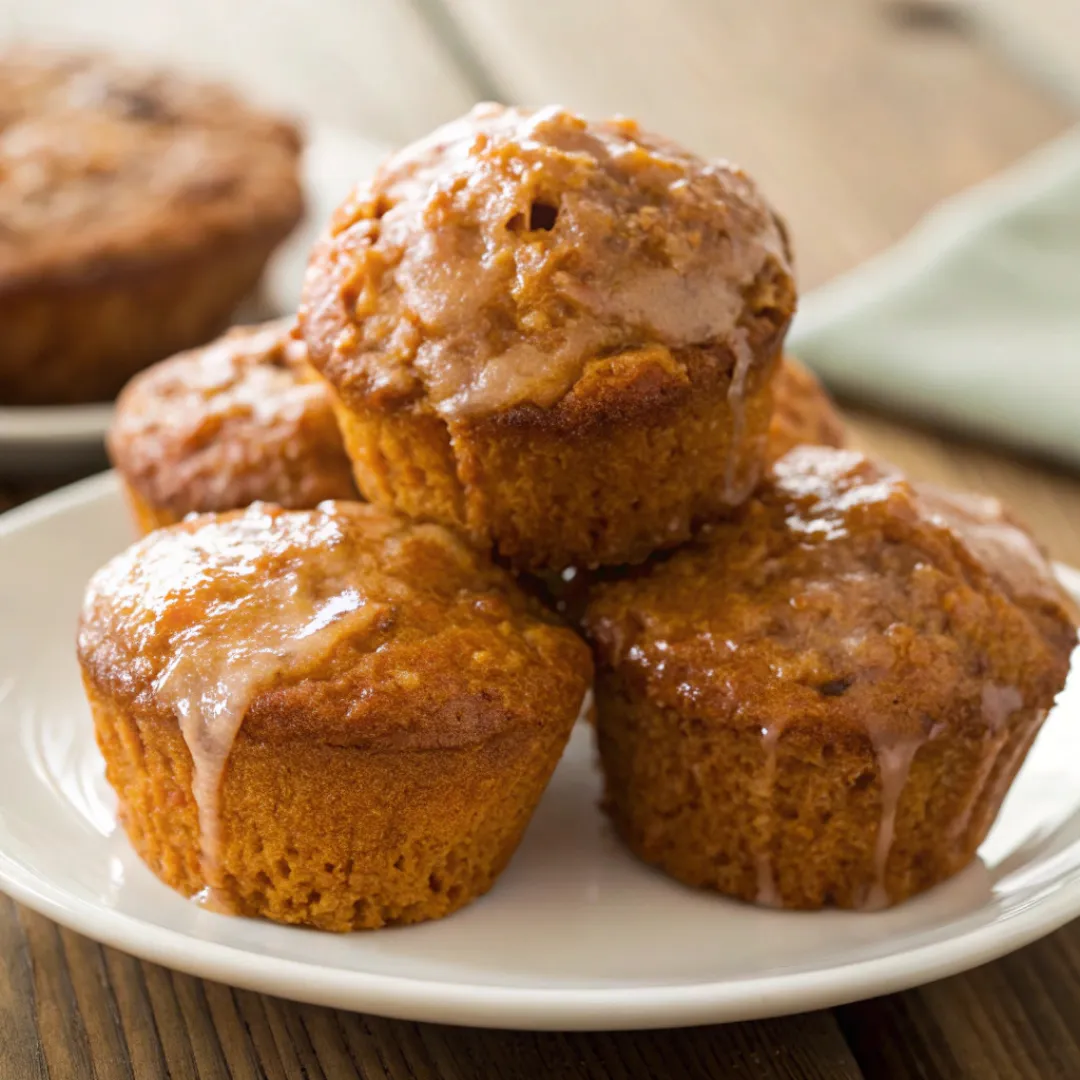Pumpkin muffins are a delicious treat that’s perfect for fall or any time of the year. They’re moist, flavorful, and filled with warm spices that make them a comforting snack or dessert. However, one common problem that bakers often face is dealing with sticky pumpkin muffins. If you’ve ever wondered, “Why are my pumpkin muffins sticky?” you’re not alone. Sticky muffins can be frustrating, especially when you’re expecting a soft, fluffy texture with a slightly crisp top.
If you’re a fan of pumpkin treats, you might also enjoy trying out these Pumpkin Chocolate Chip Cookies, which offer a delicious blend of pumpkin and chocolate flavors. This combination provides another way to explore the warmth and sweetness of pumpkin in baking.
Why Are My Pumpkin Muffins Sticky?
There are several reasons why pumpkin muffins can end up sticky on top or throughout. Understanding the root causes can help you make the necessary adjustments to achieve perfectly textured muffins. Here are the most common reasons:

Excess Moisture in the Recipe
Pumpkin puree, one of the main ingredients in pumpkin muffins, contains a high level of moisture. When combined with other wet ingredients like eggs, milk, or oil, the overall moisture content can be too high, leading to sticky muffins. The higher moisture content can also prevent your muffins from developing a crispy exterior, which results in a sticky or tacky top.
Solution
Adjust the liquid ingredients in your recipe. If you notice that your muffins are consistently sticky, try reducing the amount of pumpkin puree or other wet ingredients. For example, if your recipe calls for one cup of pumpkin puree, consider using ¾ cup instead. Alternatively, add a little extra flour or dry ingredient, such as rolled oats, to absorb the excess moisture without altering the flavor too much.
Overmixing the Batter
Overmixing the batter is another common cause of sticky muffins. When you overmix, it can break down the gluten structure in the flour, resulting in dense, sticky muffins. Overmixing also leads to a tougher texture and can cause the muffins to rise unevenly.
Solution
Mix your muffin batter until just combined. It’s okay if there are a few lumps; they’ll disappear during baking. Remember, the key to light, fluffy muffins is minimal mixing. Use a spatula or wooden spoon instead of an electric mixer to avoid overmixing the batter. This simple change can make a big difference in the final texture of your muffins.
High Humidity Levels
Humidity plays a significant role in baking. When the air is humid, your muffins can absorb extra moisture, making them sticky on the surface or inside. This is particularly common in regions with tropical or rainy climates, where the air carries more moisture.
Solution
If you live in a humid area, try baking on a day when the humidity is lower. Alternatively, store your muffins in a cool, dry place to prevent them from becoming sticky. You can also lightly dust the tops of your muffins with a bit of flour before baking to help absorb extra moisture. Additionally, consider using a dehumidifier in your kitchen while baking to reduce the humidity levels and create a more controlled environment.
Underbaking the Muffins
One of the most common reasons why pumpkin muffins turn out sticky is underbaking. If the muffins don’t bake long enough, they can retain moisture and become sticky once they cool down. Incomplete baking can lead to a soggy texture, which prevents the muffins from setting properly.
Solution
Check for doneness by inserting a toothpick into the center of a muffin. If it comes out clean or with a few crumbs, your muffins are done. Bake the muffins for a few more minutes if the toothpick has wet batter on it. If your muffins tend to brown too quickly on the outside while remaining undercooked inside, try lowering the oven temperature by 10-15 degrees Fahrenheit and baking them for a longer period.
Too Much Sugar
Sugar is a hygroscopic ingredient, meaning it attracts moisture from the air. If your pumpkin muffin recipe contains too much sugar, it can lead to sticky tops. Excess sugar can also caramelize on the surface, creating a sticky layer that remains even after cooling.
Solution
Reduce the amount of sugar in your recipe slightly. This can help prevent stickiness without compromising the sweetness or flavor of your muffins. Start by reducing the sugar by about ¼ cup and adjust as needed. If you want to maintain sweetness, consider using natural sweeteners like honey or maple syrup, which have a lower glycemic index and can provide moisture without making the muffins sticky.
Cooling the Muffins Improperly
How you cool your muffins can significantly affect their texture. If you leave the muffins in the pan for too long, the trapped steam can cause stickiness, making the tops wet and sticky. Muffins left in the pan continue to cook from residual heat, which can lead to overcooking and a less desirable texture.
Solution:
Transfer your muffins to a wire rack as soon as they’re cool enough to handle. This allows air to circulate around them and prevents condensation from forming, which can lead to a sticky texture. Make sure your wire rack is elevated, so air can flow from all sides, ensuring that your muffins cool evenly.
Overripe Pumpkin Puree
Using overripe or watery pumpkin puree can increase the moisture content of your batter, resulting in sticky muffins. This is especially true when using homemade pumpkin puree, which can vary in consistency.
Solution
Use fresh pumpkin puree or drain canned pumpkin puree to remove excess liquid before adding it to your batter. Place the puree in a fine-mesh strainer or cheesecloth and let it sit for a few minutes to remove the extra moisture. This will help maintain the right moisture balance in your muffins and prevent them from becoming sticky.
How to Prevent Sticky Pumpkin Muffins
Now that you know the main reasons why pumpkin muffins can turn out sticky, here are some pro tips to help you avoid this issue:

Measure Ingredients Accurately
Accurate measurements are crucial in baking. Too much or too little of any ingredient can affect the texture of your muffins. Use measuring cups and spoons for precise measurements, and consider using a kitchen scale for even more accuracy. Measuring flour correctly is especially important, as using too much can make your muffins dense, while too little can make them sticky.
For more guidance on this, refer to this helpful guide How to Measure Ingredients Accurately to ensure your measurements are precise every time.
Use Room Temperature Ingredients
Using ingredients at room temperature ensures that they blend more easily, resulting in a smoother batter. This helps prevent overmixing and creates a more even texture in your muffins. Cold ingredients can cause the batter to seize up, leading to uneven baking.
Tip: Take your eggs, milk, and butter out of the refrigerator about 30 minutes before baking. Room temperature ingredients will incorporate more smoothly, resulting in a better muffin texture.
Don’t Overfill the Muffin Cups
Filling the muffin cups too high can cause the batter to spread unevenly, leading to sticky tops. Fill each cup about two-thirds full to allow room for the muffins to rise properly. Overfilled cups can also lead to overflow, resulting in muffins that stick to the pan or paper liners.
Extra Tip: Use a cookie scoop or an ice cream scoop to measure the batter for each muffin cup. This ensures even portions and consistent baking.
Avoid Storing Muffins in Airtight Containers Immediately
Storing hot muffins in an airtight container can trap steam, making them sticky. Allow your muffins to cool completely before storing them, and consider using a container with a paper towel at the bottom to absorb excess moisture. This simple step helps maintain the ideal texture and prevents your muffins from becoming soggy.
Adjust the Baking Time and Temperature
Every oven is different, and baking times may vary. Keep an eye on your muffins and adjust the baking time or temperature as needed. Baking your muffins at a slightly higher temperature for a shorter time can help create a firmer top.
Tip: Try baking your muffins at 375°F (190°C) instead of 350°F (175°C) to achieve a golden, non-sticky crust. If you’re using a convection oven, reduce the temperature by 25 degrees to avoid over-baking.
Add a Streusel Topping
Adding a streusel topping made of flour, sugar, and butter can help prevent stickiness on top of your muffins. The topping acts as a barrier, absorbing moisture and creating a delicious, crumbly texture. You can also add nuts, oats, or cinnamon to enhance the flavor and texture of the streusel.
Store Muffins with Bread
If you’ve already baked your muffins and they’re sticky, place a slice of bread in the container with them. The bread will absorb the excess moisture, leaving your muffins less sticky. This method works well for reviving muffins that have become sticky after storage.
Frequently Asked Questions
Why are my pumpkin muffins sticky on top?
Sticky tops are often caused by excess moisture, high humidity, or improper cooling. Try reducing the liquid ingredients, cooling the muffins on a wire rack, and avoiding overmixing to prevent sticky tops.
How do I fix sticky muffins after baking?
If your muffins are already sticky, place a slice of bread in the container with them to absorb excess moisture. You can also lightly toast the muffins in an oven for a few minutes to dry out the tops.
Can I reduce the sugar in my pumpkin muffin recipe to prevent stickiness?
Yes, reducing the sugar slightly can help prevent stickiness, as sugar attracts moisture. Just be careful not to reduce it too much, as it can affect the overall flavor and texture of your muffins.
How long should I let my muffins cool before storing them?
Let your muffins cool for at least 10–15 minutes on a wire rack before transferring them to a container. This prevents trapped steam, which can lead to stickiness.
Is it normal for pumpkin muffins to be sticky?
A little stickiness can be normal due to the moisture from pumpkin puree, but they shouldn’t be overly sticky. If your muffins are excessively sticky, try adjusting your recipe or baking method using the tips provided.
Conclusion
Sticky pumpkin muffins can be a frustrating baking problem, but understanding the reasons behind it and applying the right techniques can help you achieve perfectly moist and fluffy muffins every time. Whether it’s adjusting your recipe, paying attention to baking times, or using proper cooling methods, these tips will guide you in preventing sticky muffins and creating delicious treats.

